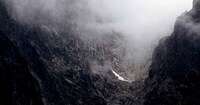The twilight of Africa’s glaciers

They’ve been a source of wonder for generations. A hike up Mount Kenya shows what’s being lost.
Warning: This graphic requires JavaScript. Please enable JavaScript for the best experience.
Africa is home to three glacier-capped mountains. Within decades, scientists say, the glaciers will be gone. Mount Kenya’s will be the first to go, with researchers predicting their disappearance as soon as 2030. The mountain would be among the first in the world to entirely lose its glaciers because of human-induced climate change.
The peaks of Mount Kenya — once covered in blinding white ice and now an arid brown — are a testament to losses already suffered in this part of Africa and a harbinger of what is to come.
The 17,000-foot mountain straddling the equator about 85 miles north of Nairobi is Africa’s second highest. For generations, Mount Kenya has been a source of tourism, of scientific study, of wonder and of lore. Its verdant slopes have also become a refuge for Kenyans battered by years-long drought linked to climate change. But even here, rain is more sporadic than it used to be.
When there is not enough grass to graze their livestock in their hometowns, herders come to the base of the mountain. “We are chasing the rain,” said Elijah Kakilan, who had walked five days from his village of Chumvi. “The mountain is our only option.”
On once fertile farms around the mountain’s base, harvests have failed in recent years as rain has become scarce. Farmers have tried pumping in water from Mount Kenya’s streams and rivers, but these are already depleted because of overuse and reduced rainfall.
As he stood in a dusty field, Musa Ole Kirobi, 71, pointed to the carcasses of his dead cows. Of the 40 he once owned, 28 had died of starvation in the past two years. Fields once filled with maize, beans and potatoes were empty. His children and grandchildren were hungry.
The Maasai elder said he still looks to the mountain’s peaks for guidance. When they are covered in white, he believes it means luck. In recent years, they’ve been bare.
Santiwuan Nangunye and her husband have lost 48 cows because of the lack of rain. “All our livestock are finished,” Maripet Ole Nangunye and his wife, who have been married for more than 50 years, said at the same time.
Describing the fate of the glacier, Farrin Savage, a 7-year-old whose father and grandfather run a wilderness exploration company, put it like this: “It’s going to be extinct, because Kenya is boiling in these times.”
Researchers who have studied the retreating glaciers on Mount Kenya and Mount Kilimanjaro in Tanzania say their shrinkage is largely caused by changes in ocean weather patterns linked to global warming. Those changes mean that across East Africa, there has been less-predictable rain and longer periods of drought. And in the mountains, there’s been less snow.
“The glaciers starve without snowfall,” said Douglas Hardy, a glacier scientist at the University of Massachusetts at Amherst. “They are suffering for the same reason people are: a lack of precipitation.”
Masses of white ice covered vast swaths of this mountain during the most recent ice age. As the glaciers withdrew, they left behind the sloping valleys and rocky moraines through which hikers now trek.
Today, the moraines are everywhere. The number of glaciers on the mountain has dropped from 18 in 1899 to 10 in 2004. Since then, scientists believe the loss has only accelerated.
Lawrence Gitonga, 67, has been hiking Mount Kenya for more than 35 years as a professional guide, and when he first saw the Lewis Glacier — which is Mount Kenya’s largest and one of the best-studied tropical glaciers in the world — he was terrified of the hulking white mass. He had learned about Mount Kenya’s glaciers in school but said he never expected something so big. Crossing without slipping seemed impossible. Terrified, he froze.
When Gitonga looks at what remains of the Lewis today, listening to the popping of ice melting, he said he mourns.
“This,” he said, “has been destroyed by man.”
“It’s so small and sad,” said Leonardo Bravin, a 32-year-old Italian trekker, after seeing the Lewis Glacier, which scientists estimate lost 90 percent of its volume between 1934 and 2010.
As glaciers get smaller, they have less snowfall to absorb solar radiation. So the smaller a glacier becomes, the more quickly it melts, said glaciologist Rainer Prinz, who has led studies of the Lewis Glacier by researchers at the University of Innsbruck in Austria.
How long it remains, Prinz said, depends in part on a bleak question: How small does a glacier have to get before it’s no longer considered a glacier at all?
His team ran tests to determine if altering the environment — for instance, making it slightly colder or slightly wetter or snowier — would allow Mount Kenya’s glaciers to survive.
But they found that it’s already too late.






